Custom Software Development
At Castigroup we believe that custom-developed software is a strategic investment that should enable your business to generate revenue. With a modular approach, we ensure quick-to-market, value-added solutions which are best for growth.
Already have a
project in mind?
Our Custom Software Development services include
Credit vetting solutions
We provide credit vetting solutions to ensure a secure and reliable assessment of an individual's creditworthiness, enabling businesses to make informed financial decisions and mitigate potential risks with functional credit verification.

Learning Management Systems (LMS)
We can create an enhanced learning experience with a functional custom Learning Management System (LMS) that provides learners with a user-friendly interface, interactive content, and personalised learning paths, leading to a more engaging and effective learning experience.

Online travel booking platforms
We leverage our expertise in travel agency software development and artificial intelligence to develop solutions that cover a wide variety of business needs, cases and requirements including online booking engines, API Integration, Reporting Platform Integration and Payment Gateway Integration.

Business solutions software
We can develop custom software for the integration and automation of numerous business processes that a company or a small business has to accomplish, like marketing, logistics, shipping, operations, supply chain, and customer management.

E-commerce development services
We guarantee fully functional e-commerce stores. Our custom e-commerce development includes intuitive frontend interfaces and responsive designs while managing data, transactions, and business logic backend to support efficient operations and effective management of the online store.

Quoting software and onboarding platforms
Contribute to improved efficiency and customer satisfaction with streamlined sales processes, enhanced customer interactions, and accelerated client onboarding with our customised options of quoting and onboarding platforms.

Mobile app development
A mobile app with tailored features results in improved sales performance and CRM. Get streamlined sales processes, real-time data insights, and enhanced customer interactions with customised mobile app development for Android and iOS.

Airline operations software
Tailor-made airline business applications assist in managing day-to-day activities, like fleet management, flight scheduling, maintenance and regulatory compliance while enhancing overall operational performance and customer experience.

Integration solutions services
Enabling a frictionless flow of data and processes across diverse software systems, ensuring operational fluidity and data integrity.



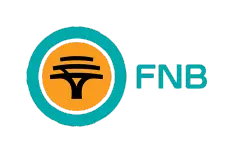
Our Custom Software Development services include












Let’s plan your project
We have experience in building new mobile or web apps or improving existing applications.
GET STARTED
Business challenges we help solve

Bridging the
IT-skills gap
Creating tailored solutions that align with an organisation's specific needs allows employees to work more efficiently with user-friendly interfaces and reduces the dependency on specialised technical skills. This empowers a broader range of staff to contribute effectively to the company's IT processes and goals.
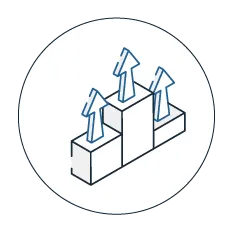
Quick-to-market solutions
Focus on the specific business needs, eliminating unnecessary features, and leveraging agile development methodologies which result in rapid prototyping, testing and deployment cycles. Adapt swiftly to changing market demands and gain a competitive edge with quick-to-market solutions.
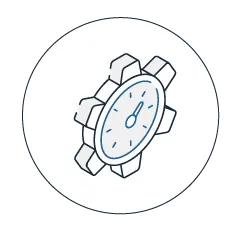
Simplify processes and enhance efficiency
Reduce operational costs and improve decision-making by creating bespoke solutions that align with the business’s unique requirements, streamlining complex processes, automating repetitive tasks, and integrating disparate systems. Simplify processes and it will lead to enhanced efficiency.
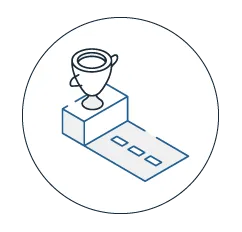
Seize every business opportunity
Custom software development can address business challenges by tailoring solutions to specific needs, enabling companies to seize every business opportunity through enhanced agility, efficient processes, and innovative features, ultimately leading to a competitive edge and maximising growth potential.
Software Development Life Cycle (SDLC)
The Software Development Life Cycle (SDLC) is a framework for managing the various stages and activities involved in developing software applications from concept to completion.
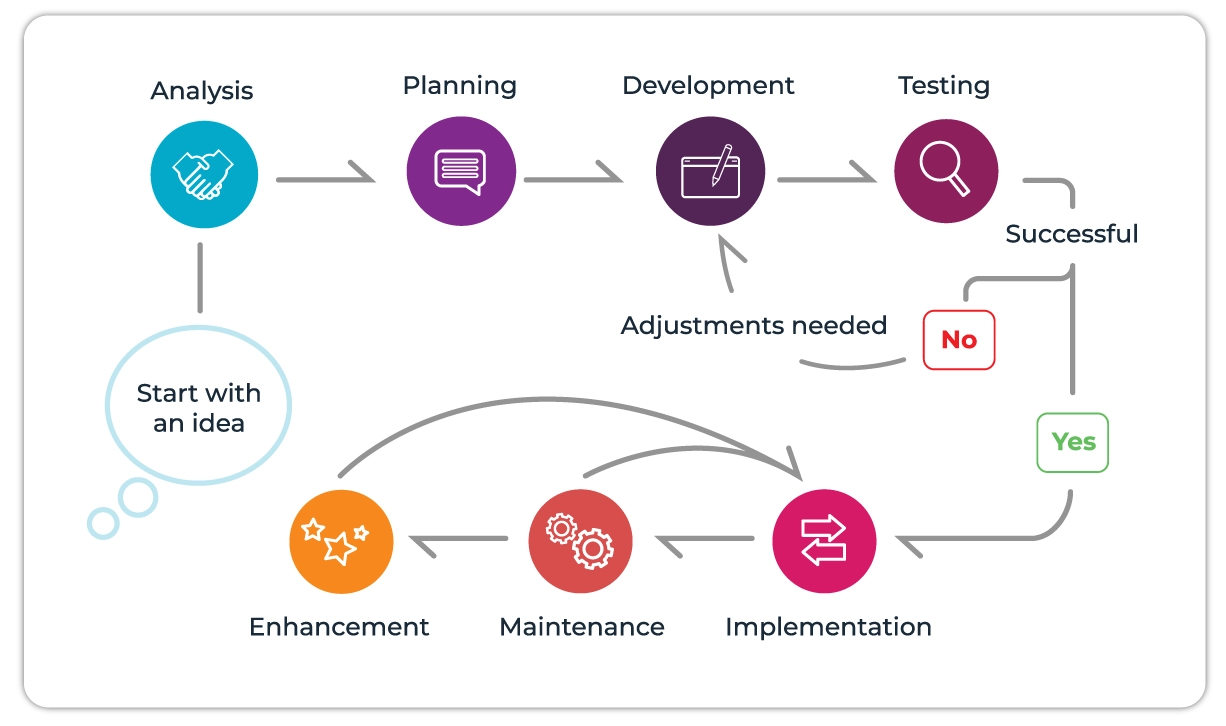
 Consulting
Consulting
We kick off with a discussion to define the software development project’s requirements, goals and outcomes.
Goal: Define client requirements
- Define any prototype system requirements.
- Evaluate alternatives to existing prototypes.
- Define goals.
- Define requirements.
- Define outcomes.
Outcome: Setting client requirements.
 Planning
Planning
In the planning phase, we clarify the features, and functionality and stipulate the exact deliverables and limitations for the development project.
Goal: Define client & direction requirements in the software development process.
- Carry out user research.
- Analyse the competitors.
- Establish business goals.
- Measure success.
- Map the customer journey.
- Plan the budget.
Outcome: Setting system requirements.
 Development / Design
Development / Design
From planning we go over building the software product. It involves writing code, integrating systems and designing a user experience and interface.
Goal: To adapt requirements into detailed software building.
- Functionality.
- Appearance.
- Quality.
Outcome: Software design description.
 Testing
Testing
Our team does thorough testing to ensure that the software product or solution works as intended. Various types of testing are done that includes unit testing, testing integrations, and user acceptance testing.
Goal: Translate the design of the system into code.
- Use proper guidelines.
- Supervise every developer.
- Automate deployment process.
- Nourish the best programming practices.
Outcome: Testable, functional software, with documentation on source coding.
 Implementation / Deployment
Implementation / Deployment
After passing rigorous testing the software product is ready for deployment in a production environment making it available for end-users.
Goal: Software delivery to a target device.
- Preparation.
- Testing.
- Automate deployment process.
- Deployment.
Outcome: Entirely operational software in an actual environment.
 Maintenance
Maintenance
To ensure the software solutions keep running smoothly ongoing maintenance is required. Software maintenance includes monitoring, deploying updates and fixing any bugs that may occur.
Goal: Ongoing monitoring and updating.
- Removing all the faults before delivery.
- Additional unplanned modifications.
Outcome: Utter user experience and productivity.
 Enhancement
Enhancement
After using the software solutions for some time, requirements might change which involves updating existing features or adding new functionality.
Goal: Ongoing evaluation and enhancement.
- Bug fixing.
- Upgrade software versions.
- Enhancement of the existing software.
Outcome: Solutions continue to perform as per the specifications.
We kick off with a discussion to define the software development project’s requirements, goals and outcomes.
Goal: Define client requirements
- Define any prototype system requirements.
- Evaluate alternatives to existing prototypes.
- Define goals.
- Define requirements.
- Define outcomes.
Outcome: Setting client requirements.
In the planning phase, we clarify the features, and functionality and stipulate the exact deliverables and limitations for the development project.
Goal: Define client & direction requirements in the software development process.
- Carry out user research.
- Analyse the competitors.
- Establish business goals.
- Measure success.
- Map the customer journey.
- Plan the budget.
Outcome: Setting system requirements.
From planning we go over building the software product. It involves writing code, integrating systems and designing a user experience and interface.
Goal: To adapt requirements into detailed software building.
- Functionality.
- Appearance.
- Quality.
Outcome: Software design description.
Our team does thorough testing to ensure that the software product or solution works as intended. Various types of testing are done that includes unit testing, testing integrations, and user acceptance testing.
Goal: Translate the design of the system into code.
- Use proper guidelines.
- Supervise every developer.
- Automate deployment process.
- Nourish the best programming practices.
Outcome: Testable, functional software, with documentation on source coding.
After passing rigorous testing the software product is ready for deployment in a production environment making it available for end-users.
Goal: Software delivery to a target device.
- Preparation.
- Testing.
- Automate deployment process.
- Deployment.
Outcome: Entirely operational software in an actual environment.
To ensure the software solutions keep running smoothly ongoing maintenance is required. Software maintenance includes monitoring, deploying updates and fixing any bugs that may occur.
Goal: Ongoing monitoring and updating.
- Removing all the faults before delivery.
- Additional unplanned modifications.
Outcome: Utter user experience and productivity.
After using the software solutions for some time, requirements might change which involves updating existing features or adding new functionality.
Goal: Ongoing evaluation and enhancement.
- Bug fixing.
- Upgrade software versions.
- Enhancement of the existing software.
Outcome: Solutions continue to perform as per the specifications.
 1. Consulting
1. Consulting  2. Planning
2. Planning  3. Development / Design
3. Development / Design  4. Testing
4. Testing  5. Implementation / Deployment
5. Implementation / Deployment  6. Maintenance
6. Maintenance  7. Enhancement
7. Enhancement